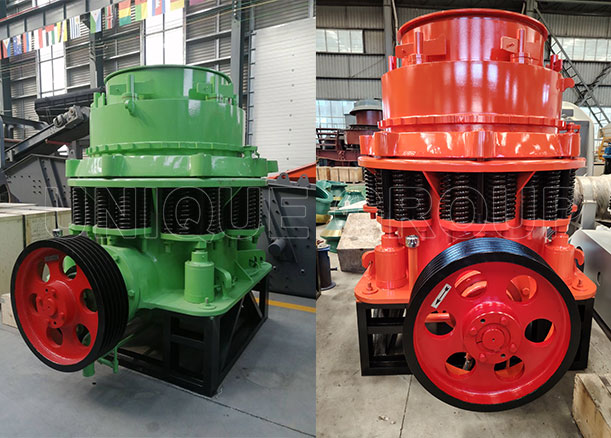
 Hot Product
Hot Product
 Hydraulic cone crushers are widely used in mining, quarrying, and aggregate production due to their high efficiency and crushing capacity. However, the wear parts, such as mantles, concaves, and eccentric bushings, degrade over time, necessitating periodic replacement. The replacement cycle of these components is influenced by multiple factors, including material properties, operational conditions, and maintenance practices. Understanding these factors can help optimize crusher performance and reduce downtime.
Hydraulic cone crushers are widely used in mining, quarrying, and aggregate production due to their high efficiency and crushing capacity. However, the wear parts, such as mantles, concaves, and eccentric bushings, degrade over time, necessitating periodic replacement. The replacement cycle of these components is influenced by multiple factors, including material properties, operational conditions, and maintenance practices. Understanding these factors can help optimize crusher performance and reduce downtime.
This article explores the key factors affecting the wear part replacement cycle in hydraulic cone crushers, providing insights for operators to extend component lifespan and improve cost efficiency.
The durability of wear parts primarily depends on their material composition and manufacturing quality.
Manganese Steel vs. High-Chromium Iron:
l Standard manganese steel (Mn14, Mn18, Mn22) offers good impact resistance but wears faster in abrasive conditions.
l High-chromium iron (e.g., Cr26, Cr28) provides superior abrasion resistance but may be brittle under high-impact loads.
l Composite materials (e.g., ceramic inserts) further enhance wear resistance in specific applications.
· Heat Treatment and Hardness:
l Proper heat treatment improves hardness and toughness. Over-hardening can lead to cracking, while insufficient hardening accelerates wear.
l Optimal hardness ranges (e.g., 450–550 HB for manganese steel) balance wear resistance and structural integrity.
· Manufacturing Defects:
l Poor casting quality, porosity, or inconsistent metallurgy can lead to premature failure.
The working environment and crushing parameters significantly impact wear rates.
l Abrasiveness: Highly abrasive materials (e.g., granite, basalt) accelerate wear compared to softer rocks (e.g., limestone).
l Feed Size and Gradation: Oversized or uneven feed increases stress on wear parts, causing uneven wear patterns.
l Moisture and Clay Content: Sticky materials can cause packing, leading to increased friction and localized wear.
l Closed-Side Setting (CSS): A smaller CSS increases inter-particle crushing but also intensifies wear.
l Cavity Design: Different chamber profiles (e.g., standard, short-head) distribute wear differently.
l Speed and Stroke: Higher eccentric speeds or excessive stroke lengths may increase wear rates.
l Continuous overloading or fluctuating feed rates cause uneven stress distribution, shortening part lifespan.
l Optimal feed control (e.g., choke feeding vs. regulated feeding) affects wear patterns.
Proper maintenance and operational discipline play a crucial role in prolonging wear part life.
· Lubrication System Efficiency:
l Inadequate lubrication increases friction and heat, accelerating wear on bushings and bearings.
l Contaminated oil (e.g., with metal particles) exacerbates component degradation.
· Regular Inspection and Adjustment:
l Monitoring wear patterns (e.g., mantle/concave wear depth) helps schedule timely replacements.
l Adjusting the CSS and checking for loose components prevent uneven wear.
· Proper Installation and Alignment:
l Misaligned components cause uneven load distribution, leading to premature failure.
l Incorrect torque on bolts or improper seating of liners can induce stress concentrations.
External conditions also influence wear part longevity.
· Temperature Extremes:
l High temperatures soften metal surfaces, increasing wear rates.
l Cold environments may embrittle materials, leading to cracking.
· Dust and Corrosion:
l Dust ingress accelerates abrasive wear on moving parts.
l Moisture or chemical exposure (e.g., acidic ores) promotes corrosion, weakening structural integrity.
· Operator Skill and Training:
l Inexperienced operators may misuse settings or ignore early signs of wear, reducing part lifespan.
Balancing cost and performance is essential for optimizing replacement cycles.
· Cost-Benefit Analysis:
l Premium wear parts may have higher upfront costs but lower long-term replacement expenses.
l Frequent replacements increase downtime and labor costs.
· Advanced Monitoring Technologies:
l Real-time wear sensors and predictive maintenance tools help optimize replacement timing.
l AI-driven analytics can forecast wear trends based on historical data.
The replacement cycle of wear parts in hydraulic cone crushers is influenced by a complex interplay of material properties, operational conditions, maintenance practices, and external factors. By selecting high-quality materials, optimizing crushing parameters, adhering to strict maintenance protocols, and leveraging modern monitoring technologies, operators can significantly extend component lifespan and enhance crusher efficiency.
Proactive management of these factors not only reduces operational costs but also ensures consistent crushing performance, minimizing unplanned downtime in demanding industrial applications.

Copyright © 2013 Zhengzhou Unique Industrial Equipment Co., Ltd. All Rights Reserved.


